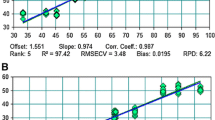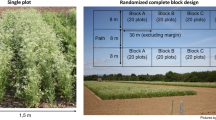Summary
The genetic architecture of seed yield, oil content and their components was studied in a diallel cross of F1 and F2: eleven parents, representing an adequate diversity for all considered characters in safflower were used. Combining ability analysis revealed the predominance of gca variance for plant height, total capitula, seed weight, seed number and seed yield in F1 and F2 generations and for days to flowering and oil content in F1. The analysis of components of variance indicated that the non-additive factor was the major influence on total capitula and seed yield in F1s, and F2s, and on plant height, seed weight and seed number in the F2 alone. The heterogeneity of the dominance component over generations has been attributed to coupling phase linkage. All four Indian parents, namely S 144, A1, MS 49 and 6 spl, together with G 1157 and US 104 in the exotic group, were the best combiners for seed yield and/or for one of its components while the remainder of the exotic parents were characterized by high gca effects for oil content. VFstp 1 and Frio were the only parents approximating both properties of oil content and seed yield. Breeding methods, such as biparental mating followed by reciprocal recurrent selection, were suggested for the simultaneous improvement of seed yield and oil content.
Similar content being viewed by others
Literature
Abel, G.H. (1976): Inheritance of stem length and its components in safflower. Crop Sci. 16, 374–376
Ehdaie, B.; Ghaderi, A. (1978): Inheritance of some agronomic characters in a cross of safflower. Crop Sci. 18, 544–547
Griffing, B. (1956): Concept of general and specific combining ability in relation to diallel crossing system. Aust. J. Biol. Sci. 9, 463–493
Hanson, W.D. (1959): The break up of initial linkage blocks under selected mating systems. Genetics 44, 857–868
Hayman, B.I.: (1954): The theory and analysis of diallel crosses. Genetics 42, 336–355
Knowles, P.F. (1969): Modification of quantity and quality of safflower oil through plant breeding. J. Am. Oil Chem. Soc. 46, 139–142
Kotecha, A.; Zimmerman, L.H. (1978): Genetics of seed dormancy and its association with other traits in safflower. Crop Sci. 18, 1003–1007
Mather, K.; Jinks, J.L. (1971): Biometrical Genetics. London: Chapman and Hall
Murty, B.R. (1979): Selection of parental material, breeding methods and evaluation procedures in developing improved crop varieties. Indian J. Genet. 39, 305–314
Robinson, H.F.; Cockerham, C.C.; Moll, R.H. (1960): Studies on estimation of dominance variance and effects of linkage bias. In: Biometrical Genetics, pp. 171–177. New York: Pergamon Press
Author information
Authors and Affiliations
Additional information
Communicated by J. Mac Key
Rights and permissions
About this article
Cite this article
Ramachandram, M., Goud, J.V. Genetic analysis of seed yield, oil content and their components in safflower (Carthamus tinctorius L.). Theoret. Appl. Genetics 60, 191–195 (1981). https://doi.org/10.1007/BF00264529
Received:
Accepted:
Issue Date:
DOI: https://doi.org/10.1007/BF00264529




